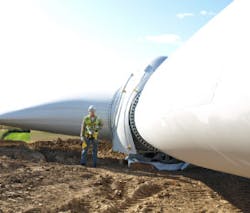Wisconsin Wind Farm Makes Producing Electricity a Breeze
During the past four years, the U.S. wind industry has contributed more than 35% of all-new generating capacity, according to the American Wind Energy Association (AWEA). The first quarter of 2011 along saw 1,100 MW of new capacity installed with another 5,600 MW currently under construction.
The Butler Ridge Wind Farm in Mayville, Wis., is helping add to these impressive numbers. Situated along the Niagara escarpment, a ridge that originates in Ontario, Canada, continues through Wisconsin, and ends in Illinois, the wind farm comprises 36 1.5MW wind turbines on a site that measures roughly 5 miles long by 2 miles wide.
“To achieve maximum wind power, the owners decided to construct the turbines along a place on the ridge that reaches an elevation of about 1,200 ft,” says Rich Vander Heiden, project manager for Menasha, Wis.-headquartered Faith Technologies, the electrical and specialty systems contractor that performed the project’s in-tower wiring and installed the turbine foundation conduits and turbine ground grid.
According to Vander Heiden, the foundation conduits and grounding portion of the project consisted of installing two ground rings with 600 MCM copper and providing and installing 5-in. PVC power conduits and 2-in. PVC communication conduits for each tower site.
“The foundations were basically a two-part installation for Boldt, who was the general contractor,” he explains. “They included an upper and a lower concrete mat that each had its own requirements for conduits and grounding. While one lower mat was being completed, an upper mat was being done at another site. Once we had our routine down, our crews worked out a system whereby, toward the end of the day, the material was sorted out for the next day’s activity.”
Project challenges included ground rods that had to be driven to a depth of 20 ft and required the use of a compressor to drive the sectional rods. Additionally, two areas required hiring a drilling and blasting subcontractor to excavate through rock to reach the desired depth.
“The in-tower wiring presented another unique challenge because it was something Faith Technologies had not encountered previously,” notes Vander Heiden. “Worker safety was paramount in our planning. Because of Faith Technologies’ experience with cell towers, we have our own in-house instructor on high tower rescue who certified each climber prior to working on the project. Each day, our safety harnesses and tooling was thoroughly inspected before any climbing occurred.”
The final leg of the project took place once the general contractor assembled the tower sections. At that time, three 6-man crews from Faith Technologies lowered power and control cabling from the top section to the down tower assembly.
“Hub height on the turbines is 80 meters,” says Vander Heiden. “One of the most exciting parts of the in-tower wiring phase, at least for some workers, was when they exited the top of the nacelle to get to the hub in order to feed its cabling to the nacelle.”
Generating enough electricity to power 18,000 homes, Faith Technologies finished its part of the Butler Ridge Wind Farm project on time and without a safety incident.
About the Author
Stefanie Kure
Content Producer - EC&M
Stefanie Kure is the senior associate editor of EC&M magazine. She holds a Bachelor of Arts degree from the University of Kansas and has more than 20 years of experience in the B2B magazine industry. In addition to EC&M, Stefanie has worked on Transmission & Distribution World magazine, Broadcast Engineering magazine, and Power Electronics Technology magazine.
